Reconviction rates - offender cohort: 2017 to 2018
Analyses of trends in reconviction statistics up to the latest cohort of 2017 to 2018.
This document is part of a collection
1. Main findings: reconviction rates for court disposals
1.1 Headline figures
(Table 1)
The trends presented in this publication have not been affected by the COVID-19 pandemic as all data, including reconvictions, fall in the period before the pandemic.
The reconviction rate and average number of reconvictions per offender (Table 1 and Chart 1) have generally decreased over the past decade. Between 2008-09 and 2017-18, the reconviction rate has fallen by 5.2 percentage points from 31.5% to 26.3%, and the average number of reconvictions per offender has decreased by 23% from 0.60 to 0.46. This aligns with the decrease seen in court business over the same period between 2008-09 and 2017-18, with a 32% decrease in the number of people proceeded against in court (Criminal Proceedings in Scotland, 2017-18). More widely, other measures of crime show decreases, with a 35% drop in recorded crime between 2008-09 and 2017-18 (Recorded Crime in Scotland, 2018-19), and the Scottish Crime and Justice Survey also reveals a similar pattern of falling incidence of crime.
Note that the Summary Justice Reform may have slightly increased the reconviction rate and average number of reconvictions per offender in 2008-09. The reconviction rate was 0.3 percentage points higher and the average number of reconvictions was 0.03 higher than the previous year. The Summary Justice Reform was designed to take less serious cases out of the justice system at an earlier stage, and to improve the efficiency of court processes, and resulted in cases being processed faster through the courts.
Over the shorter-term, the reconviction rate decreased by one percentage point from 27.3% in 2016-17 to 26.3% in the latest cohort of 2017-18. In the same period the average number of reconvictions per offender also decreased by 4% from 0.48 to 0.46.
The size of the cohort has decreased in the past two years, after increasing in the three years before that. In 2017-18 the cohort size decreased by 10% to 36,700 from 40,607 in 2016-17. This is the smallest cohort in the past 21 years, and reflects the decreases in the number of people convicted seen in the Criminal Proceedings Statistics since 2015-16. The slight lag in the reconviction cohort compared to the number of people convicted is likely to be because those given custodial sentences are counted at sentence date in the Criminal Proceedings Statistics, whereas they are counted later in a reconvictions cohort at the estimated time when they are released.
1.2 Age and gender
(Table 2, Table 3, Table 4 and Table 5)
Gender
Gender is self-reported to the police at the time when the offender’s details are entered on the CHS.
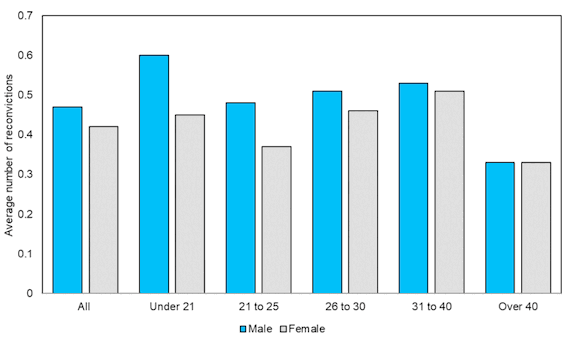
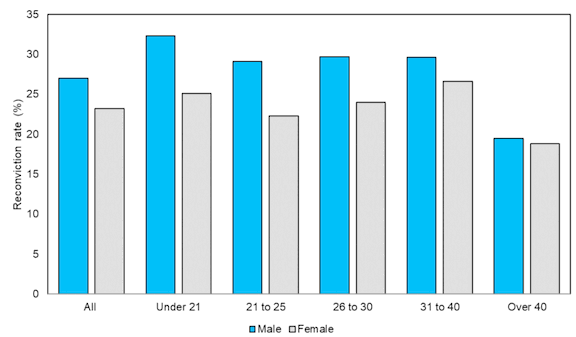
Both measures of reconvictions decreased for males and females over the past year.
Males make up the vast majority of offenders in each cohort, with males making up 83% of the cohort in 2017-18. Continuing a persistent long-term trend, males have higher reconviction rates and a higher average number of reconvictions per offender than females (Table 2 and Chart 3 and 4). However, the gap has narrowed in recent years. In 2017-18 the reconviction rate was 27.0% for males and 23.2% for females, and average number of reconvictions per offender was 0.47 for males, and 0.42 for females.
Both measures of reconvictions for males and females are lower than they were last year. For males, the reconviction rate decreased by 1.2 percentage points from 28.2% in 2016-17 to 27.0% in 2017-18, and the average number of reconvictions decreased by 4% from 0.49 to 0.47. For females, the reconviction rate was slightly lower than last year, with the figure of 23.2% in 2017-18 being 0.3 percentage points lower than the figure of 23.5% in 2016-17.
Over the longer-term, reconvictions for males and females have generally decreased.
In the past decade, the average number of reconvictions fell by 23% for males from 0.61 in 2008-09 to 0.47 in 2017-18, and the reconviction rate fell by 5.5 percentage points from 32.5% to 27.0% in the same period. The figures for males are now similar to those for females just over a decade ago. For females, the average number of reconvictions decreased by 21% from 0.53 in 2008-09 to 0.42 in 2017-18, and the reconviction rate decreased by 3.3 percentage points from 26.5% to 23.2% in same period.
Age
Almost all age groups showed some decrease in both measures of reconvictions between 2016-17 and 2017-18.
The decreases in the reconviction rate ranged from a 1.6 percentage point decrease in 21 to 25 year olds, to a 0.7 percentage point decrease in the 26 to 30 and over 40 age groups (Table 3). The only exception to the decrease was the average number of reconvictions for the 26 to 30 age group that stayed the same.
Reconviction rates and average number of reconvictions for under 21s were the highest of the age groups in 2017-18 (31.3% and 0.58, respectively), and lowest for the over 40s (19.4% and 0.33, respectively), as they have been historically. The other age groups (21 to 25, 26 to 30, and 31 to 40) had values closer to the under 21s, with reconviction rates ranging from 28.1% to 29.0%, and average number of reconvictions ranging from 0.46 to 0.53 (Table 3).
Reconvictions for Under 21s have decreased substantially over the past 21 years.
Over time, the average number of reconvictions for under 21s have decreased by more than a third (38%), from a high of 0.93 twenty one years ago in 1997-98 to the latest figure of 0.58 in 2017-18. The figures for under 21s had seen a rise in 2013-14 and 2014-15, but have decreased in the past three years and the 2017-18 figures are the lowest levels recorded in the period covered by this publication (Table 3). They are now similar to the levels that the 21 to 40 year age groups were at about five years ago.
It should also be noted that the under 21 cohort size decreased substantially in the past 21 years by almost three quarters (73%) from 13,796 in 1997-98 to 3,728 in 2017-18. It has decreased by 65% in the past decade alone from 10,757 in 2008-09. The fall is in part due to dealing with youth offending outside of court and early interventions. In terms of its effect on the national cohort size, 21 years ago the under 21 cohort represented 26% of the national cohort, compared to 10% in the most recent cohort. This large change in the under 21 cohort size, coupled with the decrease in reconvictions for this group, means that changes in this group are a significant component of the reduction in the overall national reconviction rate.
There have been long term decreases in reconvictions for the 21 to 30 age groups.
Over the past decade, the average number of reconvictions for the 21 to 25 age group has decreased by 29% from 0.65 in 2008-09 to 0.46 in 2017-18. The average number of reconviction for the 25 to 30 group is 25% lower than it was a decade ago, with a figure of 0.51 in 2017-18 compared to 0.68 in 2008-09, although the figure has been identical in the past 3 years.
Reconvictions for the over 30s have fluctuated through time.
Although reconvictions for the over 30s have decreased over the past year, they are higher than they were more than a decade ago. This compares to the under 30 age groups, which are now at the lowest levels in the period covered by this bulletin (Table 3). The cohort size for the over 40 group represented 28% of the 2017-18 cohort, compared to 12% of the cohort 21 years ago. As the over 40 group has the lowest reconviction rates of any age group, the increasing cohort size has been a partial component of the reductions seen in the overall national reconviction rate.
Age and gender
Patterns of change in reconvictions (both rates and average numbers) for males of different age groups are generally similar over time (Table 4) to those for all offenders (Table 3), as males comprise the majority of offenders in the cohort (83% in 2017-18) (Chart 5).
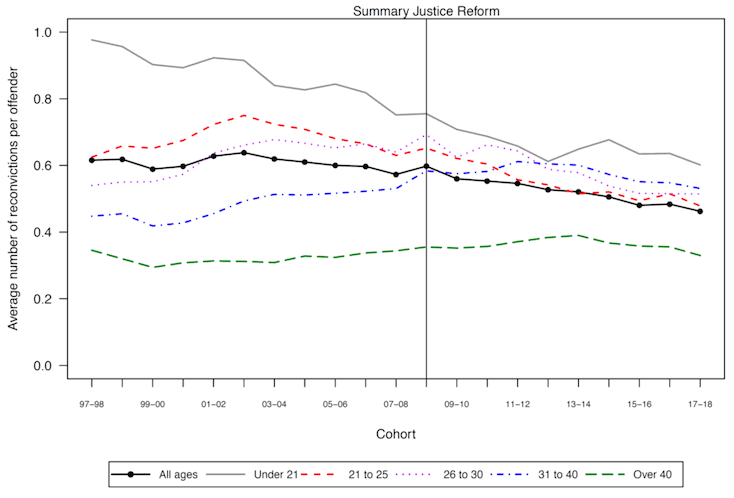
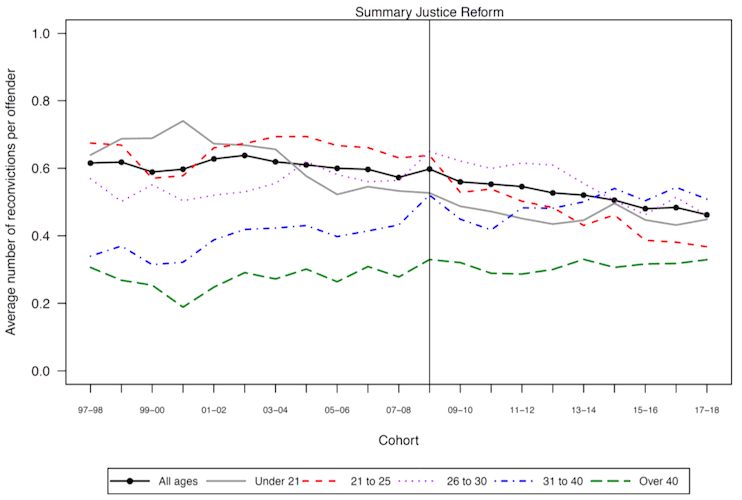
Almost all male age groups showed some decrease in both measures of reconvictions between 2016-17 and 2017-18.
The decreases ranged from a 1.9 percentage point decrease in the 21 to 25 age group, to a 0.6 percentage point decrease in the 26 to 30 year age group. The average number of reconvictions for most age groups also decreased over last year, with the exception of the 26 to 30 year age group, which did not change (Table 4 and Chart 5).
Historically, the average number of reconvictions used to decrease with age, but in recent years the pattern has changed as the gap has narrowed between the age groups. The 21 to 40 year age groups are now very similar to each other. In 2017-18, under 21s had the highest average number of reconvictions of the male age groups (0.60), followed by 31 to 40 (0.53), 26 to 30 (0.51) and 21 to 25 (0.48); with the over 40s having the lowest (0.33) (Table 4 and Chart 5).
Reconvictions for females aged under 21 and over 40 increased between 2016-17 and 2017-18.
The reconviction rate for females aged under 21 and over 40 both increased by 0.6 percentage points between 2016-17 and 2017-18. Both age groups also saw slight increases in the average number of reconvictions. Although these increases were small, they are two of the few groups presented in this bulletin that have shown some increase in reconvictions.
Over the longer term, reconvictions for females under 21 are lower than they were a decade ago, but reconvictions for the over 40s are now at their highest level. Reconvictions have fluctuated in the past decade for females under 21, and the small recent increase is within the bounds of the fluctuations seen. The reconviction rate for females over 40 has generally increased over recent years, increasing from 15.8% in 2011-12 to 18.8% in 2017-18 (Table 5 and Chart 6), and is now at its highest level in the past 21 years.
Other female age groups showed some decrease in the reconvictions or stayed the same in the past year.
The reconviction rate for females aged 26 to 30 had the biggest decrease of any of the female age groups in the past year, decreasing by 1.4 percentage points. The average number of reconvictions also decreased by 10% for this group. The reconviction rate for the 31 to 40 age group decreased by 1.2 percentage points in the past year, and the average number of reconvictions for this group decreased by 6%. There was no change in the reconviction rate for the 21 to 25 year age group over the past year, although the average number of reconvictions for this age group decreased very slightly (Table 5).
The pattern of reconvictions across female age groups is slightly different to males.
In 2017-18, the age group with the highest average number of reconvictions was the 31 to 40 group (0.51), followed by 26 to 30 (0.46), under 21 (0.45), 21 to 25 (0.37); with the lowest for the over 40s (0.33) (Chart 6). The most notable difference to males is for the under 21 age group, which has always been highest of the male age groups (Table 4 and Chart 5), but this hasn’t been the case for the under 21 female age group since 2001-02 (Table 5 and Chart 6).
1.3 Index crime
An “index crime” is the crime which resulted in the “index conviction”, the reference conviction which reconvictions are counted from. If a person was convicted for more than one charge in a set of proceedings, then the crime that was given the most serious disposal is counted as the index crime (see Annex A4). See Annex Table A1 and Annex A5 for definitions.
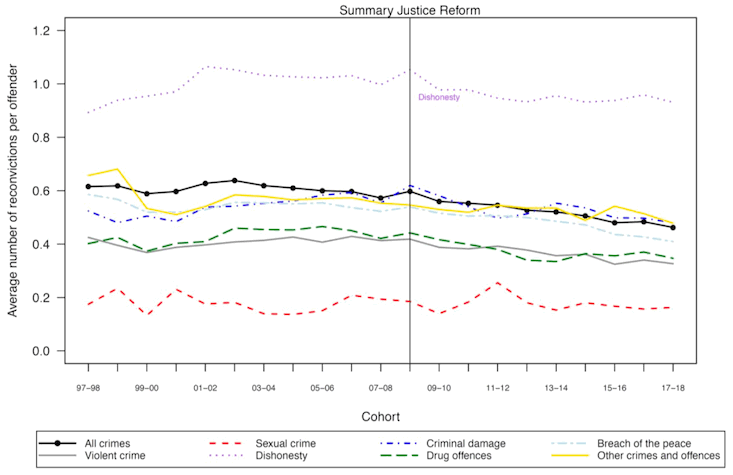
In general, offenders who were convicted for lower level index crimes which tend to be committed in higher volumes, are more likely to be reconvicted than those who commit more serious crimes.
Note that different disposals are given for different crimes, which may also affect the likelihood of reoffending.
As has been true since 1997-98, offenders with an index crime of dishonesty, for example shoplifting (see Annex Table A2 for crime groupings), have the highest average number of reconvictions per offender and reconviction rate of any of the index crimes (Table 6 and Chart 7). For offenders convicted of crimes of dishonesty in the 2017-18 cohort, the reconviction rate was 42.6%, and an average of nearly one reconviction per offender (0.93). This compares to offenders with an index crime of a sexual crime, which had the lowest reconviction rate (11.5%) and lowest average number of reconvictions per offender (0.16) of any index crime (Chart 7 and Table 6).
Offenders from the 2017-18 cohort who had index crimes other than sexual crimes or crimes of dishonesty, had an average number of reconvictions per offender ranging between 0.33 for violent crime and 0.48 for criminal damage and other crimes and offences. The reconviction rates ranged between 20.7% for violent crime, and 28.7% for other crimes and offences (Table 6 and Chart 7).
Reconvictions decreased for almost all categories of index crime over the past year, except sexual crimes.
The reconviction rate for sexual crimes increased by 0.8 percentage points from 10.7% in 2016-17 to 11.5% in 2017-18, and the average number of reconvictions remained the same at 0.16. Although reconvictions for sexual crimes have increased this year, reconvictions have fluctuated from year to year over the past 21 years with no upwards or downwards trend. The reconviction rate has ranged from a high of 14.2% in 2006-07 to a low of 9.0 in 2004-05, and the average number of reconvictions has ranged from a high of 0.26 in 2011-12 to a low of 0.13 in 1999-00 (Table 6 and Chart 7).
Other crimes and offences had the largest decrease in the reconviction rate over the past year, with a two percentage point reduction. This was followed by criminal damage (1.8 percentage point decrease), dishonesty (1.1 percentage point decrease), violent crime (0.9 percentage point decrease), drug offences (0.7 percentage point decrease), and breach of peace (0.6 percentage point decrease). All index crimes, other than sexual crimes, also saw small decreases in the average number of reconvictions per offender (Table 6 and Chart 7).
Over the past decade, trends in reconvictions across crime types have been mixed.
Violent crime, breach of the peace, and drug offences have shown a general downwards trend, whereas other groups have tended to fluctuate from year to year with no clear trend (Table 6 and Chart 7).
Reconviction crime by index crime
Table 7 shows the types of crimes that offenders in the 2017-18 cohort were reconvicted for, by each type of index crime. The majority of offenders in the cohort (almost three quarters, 73.7%) were not reconvicted for any crime. For those that were reconvicted, more were reconvicted for breach of the peace than any other type of crime (9.4% of all offenders) and fewer offenders were reconvicted for a sexual crime (0.4% of all offenders).
Table 7 also highlights the degree to which offenders specialise in particular types of crime. Offenders convicted of crimes of dishonesty, drug offences, and breach of the peace were reconvicted for the same type of crime more than other types. Even in the cases where the majority of offenders were reconvicted for the same crime as their index crime, there were still other offenders who were reconvicted for different crimes to their index crimes. This suggests that offenders do not completely specialise on a particular type of crime.
1.4 Domestic abuse index crimes and offences
(Table 8a ,Table 8b and Table 8c)
The crimes and offences crimes counted here as domestic abuse index convictions or reconvictions, are crimes and offences marked with a non-statutory domestic abuse identifier on the CHS, and in some cases with the statutory domestic abuse aggravation in addition. For example, a common assault offence committed against a partner could be marked with the statutory aggravation and a domestic abuse identifier in addition. Note that the crimes and offences are mostly referred to as “crimes” below for brevity.
Crimes and offences are marked with the identifier by the police or COPFS and used for operational purposes for prosecution. A new statutory domestic abuse aggravation was created by the Abusive Behaviour and Sexual Harm (Scotland) Act 2016 and came into effect on the 24th April 2017 for crimes that took place on or after this date. The new statutory domestic abuse aggravation is libelled on individual charges and, if proven in court, will be taken into account during sentencing. Data on this are published for the first time this year. The statutory aggravation is never applied to a proceeding without the non-statutory identifier, so the crimes and offences with the aggravation are a subset of those with the identifier. Many of the domestic abuse crimes that were convicted in court in 2017-18 are likely to have been committed prior to 24th April 2017, so there will be fewer domestic abuse index convictions and reconvictions compared to the identifier.
A new standalone offence of domestic abuse was created by the Domestic Abuse (Scotland) Act 2018. This offence covers a course of behaviour which is abusive of a person’s partner or ex-partner. This offence was introduced on 1st April 2019 which is later than the period covered by this bulletin so they are not included here. This will be included in the future once they feed into the SOI. See Annex B for information on data quality.
Table 8a and Table 8b show the reconviction rate and average number of reconvictions per offender, respectively, for index crimes marked with a domestic abuse identifier from 2009-10 to 2017-18. Reconvictions with an identifier and reconvictions for any crime (with and without an identifier) are presented separately. Index crimes without the identifier are also included as a comparison.
Table 8c is similar to Tables 8a and 8b, but shows reconvictions for index crimes with the new statutory domestic abuse aggravation in 2017-18. Reconvictions are also presented separately to show those with an aggravation and reconvictions for any crime (with and without an aggravation).
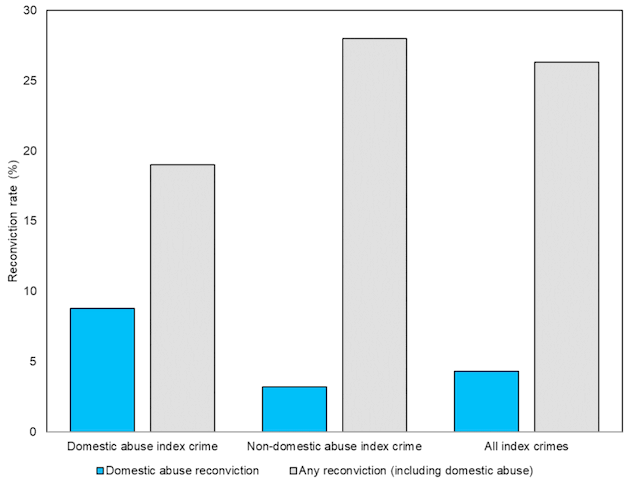
Offenders with a domestic abuse index crime were more likely to be reconvicted for a non-domestic abuse crime than a domestic abuse crime.
In 2017-18, 19.0% of offenders with an index crime marked with the domestic abuse identifier were reconvicted for any crime, compared to 8.8% reconvicted for domestic abuse crimes (Chart 8 and Table 8a). Note that the percentage reconvicted for any crime includes those reconvicted for domestic abuse crimes, so the percent reconvicted for non-domestic abuse crimes can be calculated by subtraction, which gives a figure of 10.2% of offenders with a domestic abuse index crime reconvicted for a non-domestic abuse offence.
Reconviction rates for index crimes marked with the statutory aggravation were similar to those marked with the identifier (Table 8c). In 2017-18, 17.6% of offenders with an index crime with a domestic abuse aggravation were reconvicted for any crime and 7% were reconvicted for a further crime with a domestic abuse aggravation. Note that because many of the domestic abuse crimes convicted in court in 2017-18 are likely to have been committed prior to 24th April 2017 when the statutory aggravation came into effect for crimes committed on or after this date, the number of index crimes and reconvictions with the aggravation will be lower than those with the identifier.
Reconvictions for domestic abuse index crimes decreased slightly over the past year.
Table 8a shows that the percentage of offenders with an index crime marked with a domestic abuse identifier who were reconvicted for a further domestic crime decreased slightly by 0.5 percentage points from 9.3% in 2016-17 to 8.8% in 2017-18. Table 8b shows that there was a very small decrease in the average number of reconvictions for a further domestic abuse crime for domestic abuse offenders from 0.11 in 2016-17 to 0.10 in 2017-18. Over the last seven years, the percentage of domestic abuse offenders reconvicted for a further domestic abuse crime has been similar, with small fluctuations year to year. The average number of reconvictions for a further domestic abuse crime by domestic abuse offenders has also followed a similar pattern over the past seven years.
Additional tables showing reconvictions for domestic abuse offenders with the identifier by age, gender, crime, and disposal are published alongside this bulletin. The patterns for offenders with a domestic abuse index conviction that were reconvicted for a further domestic abuse crime follow similar patterns to reconvictions for all offenders across all types of crimes that are presented in the other sections of this bulletin. For example, a higher percentage of men are reconvicted for another domestic abuse crime than women (9.4% of males and 4.9% of females in 2017-18), and reconvictions for those given custodial sentences were higher than those given community sentences. Under 21s have a slightly lower percentage reconvicted for another domestic abuse crime (6.5%), compared to age groups over 21 which are near identical and range from 8.8% to 9.2%.
1.5 Index disposal
(Table 9)
The index disposal is the sentence received for an index conviction (see Annex Table A1 and Annex A5 for definitions). If a person is convicted for more than one charge in a set of proceedings, then the charge that receives the most serious disposal is counted as the index disposal (see Annex A4).
A disposal may reduce the likelihood of reoffending as offenders are rehabilitated. However, different disposals are given for different types of crime and differing offending histories and, as seen elsewhere in this bulletin, these factors are also predictors of whether an offender is likely to reoffend or not. These factors should be considered when comparing the effectiveness of different types of sentences. Table 11 and the Reconviction rates by disposal, age, sex and previous convictions table in the additional tables published with this publication give reconviction rates for different offender characteristics for the disposals. The additional tables are found under the “supporting files” tab on the website of this publication.
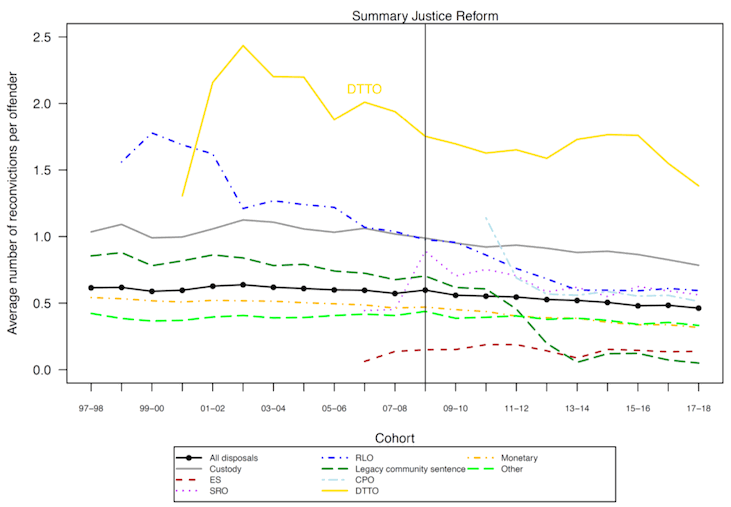
Custodial sentences
Reconviction rates for extended sentences (ES) and supervised release orders (SROs) are presented separately from other custodial sentences (Table 9). The custodial sentence category only includes those that were sent to prison or young offenders institutions, plus a small number of orders for lifelong restriction. Note that the SROs and ES are included in the custodial sentence length table along with the other custodial sentences (Table 10a).
Offenders released from a custodial sentence in 2017-18 had a higher reconviction rate and average number of reconvictions per offender than offenders given any other disposal except a DTTO.
The reconviction rate for offenders released from custody in 2017-18 cohort was 41.0%, a 1.4 percentage point decrease on the 2016-17 rate of 42.4%. This is the fourth year in a row that the reconviction rate for custodial sentences has decreased. The average number of reconvictions per offender decreased by 6% from 0.83 to 0.78 in the past year (Table 9 and Chart 9). Note that reconviction rates for different lengths of custodial sentences vary considerably which is discussed in the next section of this bulletin.
Over the last decade, for those released from custodial sentences, there has been a 21% decrease from about one reconviction per offender on average (0.99) in 2008-09, to 0.78 in 2017-18 (Table 9, Chart 9).
Extended Sentences (ES) are custodial sentences given for sexual crimes, or violent crimes that attract a custodial sentence of four years or more. ES have a period of supervision of up to 10 years in the community after the custodial sentence. If offenders breach their licence during the extended part of the sentence, they can be recalled to prison. Reconviction rates for ES, like other custodial sentences, are based on the estimated release date from the custodial part of the sentence. We do not have information on the length of the supervision period on our dataset at the moment, just the length of the custodial part of the sentence. The reconviction rates are low compared to other disposals, in part because they are generally given to sex offenders, who are typically reconvicted less than other offenders. Table 6 shows that offenders convicted of a sexual crime had the lowest reconviction rates for any index crime.
Reconviction rates for ES showed a small decrease over the past year, but the average number of reconvictions showed a small increase.
Reconviction rates for ES decreased between 2016-17 and 2017-18 by 0.7 percentage points from 11.5% to 10.8%. The average number of reconvictions in 2017-18 was 0.14, which was a slight increase on the figure of 0.13 in 2016-17. Reconvictions have fluctuated from year to year for ES, which in part is probably due to the small cohort sizes and low numbers of reconvictions, where a small change would have a greater effect on percentages compared to larger cohorts (Table 9 and Chart 9).
SROs are given for crimes other than sexual crimes and consist of a custodial sentence of one to four years, followed by a period of supervision of up to a year by a social worker. If the offender breaches the order they can be returned to prison. As with ES, we do not have information on the length of the supervision period on our dataset. Reconvictions for SROs are lower than non-supervised custodial sentences.
There was a difference in the direction of change between the reconviction rate and the average number of reconvictions for SROs.
The reconviction rate of SROs increased by 0.9 percentage points in the past year, from 36.9% in 2016-17 to 37.8% in 2017-18. In contrast, the average number of reconvictions decreased by 5% from 0.59 to 0.56 in the same period. In the last decade, reconvictions for SROs have been fluctuating, but were broadly similar in the last six years (Table 9 and Chart 9).
Community sentences: CPOs, DTTOs, RLOs
Community Payback Orders (CPOs) are a community sentence and consist of one or more of nine requirements imposed by the courts, including: offender supervision, compensation, unpaid work or other activity, mental health treatment, drug treatment and alcohol treatment. Every order must contain either an unpaid work or other activity requirement, or an offender supervision requirement (or both). If an offender fails to comply with a requirement in the order, the court can impose a number of sanctions, including a restricted movement requirement.
CPOs replaced the legacy community orders in 2011. There were still a very small number of legacy community orders in 2016-17 as they were given for offences committed prior to February 2011. During the transition from legacy orders to CPOs from 2010-11 to 2013-14, there were changes in the characteristics of offenders that were given these disposal types. Annex D gives a brief overview of the trends during the transitional period. CPOs are the mostly widely used community sentence, with a cohort size of 9,021 in 2017-18.
Reconvictions for CPO showed a relatively large decrease in the past year.
The reconviction rate decreased by 2.2 percentage points in the past year from 31.3% in 2016-17 to 29.1% in 2017-18. The average number of reconvictions per offender also showed a relatively large decrease, with a decrease of 9% from 0.56 to 0.51. This may be a one off decrease, as reconvictions for CPOs have slightly fluctuated year to year after the transitional period from 2013-14 onwards, with no upwards or downwards trend (Table 9 and Chart 9).
A Drug Treatment and Testing Order (DTTO) is a high tariff disposal for people with serious drug use problems. It includes the requirement for regular reviews by the court and that the person consents to frequent random drug tests throughout the lifetime of the order.
Offenders given a DTTO have the highest average number of reconvictions per offender and the highest reconviction rate of any disposal.
The high reconvictions are associated with the substance misuse that led to the disposal and should not be interpreted as a particular lack of effectiveness of DTTOs compared to other disposals. The average number of reconvictions per offender was 1.38 in 2017-18, which is a decrease of 11% from 1.55 in 2016-17. The reconviction rate decreased by 7.7 percentage points over the same period from 65.2% to 57.5% (Table 9 and Chart 9).
Over the longer term, reconvictions for DTTOs are lower than they were a decade ago, with the average number of reconvictions falling by 21% over the past decade from 1.75 in 2008-09 to 1.38 in 2017-18, although much of the decrease has been in the past two years. Changes in reconviction rates over the past decade show a similar pattern to changes in the average number of reconvictions.
Note that reconvictions for DTTOs tend to be revised up more than other categories published in this bulletin. The reconviction rate for the 2016-17 cohort published last year was 64.3% and the average number of reconvictions was 1.47, and they have been revised up to 65.2% and 1.55 respectively. This compares to the overall reconviction rate which increased by 0.1 percentage point and the average number of reconvictions that remained the same (see annex Table B2).
Restriction of Liberty Orders (RLOs) are imposed for periods of up to one year, and involve restricting an individual to a specified place for up to 12 hours per day and/or from a specified place for up to 24 hours.
Reconvictions for RLOs decreased in the past year.
The reconviction rate for RLOs in 2017-18 was 33.1%, which is one percentage point lower than the figure of 34.1% in 2016-17. The average number of reconvictions was 0.59 in 2017-18 which is a 3% decrease from 0.61 in the previous year.
Over the longer term, reconvictions are now much lower for RLOs than they used to be, with the average number of reconvictions decreasing by 40% over the past decade from 0.98 in 2008-09 to 0.59 in 2017-18. The reconviction rate has also decreased by 14.7 percentage points in the same period. However, in the most recent five years, reconvictions have been relatively stable. RLOs have been more widely used over the past decade, with the size of the cohort almost trebling from 594 in 2008-09 to 1,656 in 2017-18 (Table 9 and Chart 9).
Monetary and other disposals
Reconvictions for monetary disposals are low.
The reconviction rate of 19.7% for monetary disposals in 2017-18 is a decrease of 1.5 percentage points from 21.2% in 2016-17. The average number of reconvictions decreased by 6% over the same period, from 0.34 to 0.32.
The numbers of offenders with a monetary index conviction has more than halved in the past decade from 22,846 offenders in 2008-09 to 11,263 in 2017-18. This may, in part, reflect the impact of Summary Justice Reform which was designed to take less serious cases out of the court system, and deal with them using non-court disposals (see Section 2). Reconvictions have also fallen for monetary disposals in the past decade, with the average number of reconvictions decreasing by 32% from 0.47 in 2007-08 to 0.32 in 2017-18 (Table 9 and Chart 9).
Reconvictions for Other disposals are similar to monetary disposals.
For Other disposals, which includes admonishments, cautions, and absolute discharges; the reconviction rate of 20.0% in 2017-18 was slightly lower (by 0.4 percentage points) than the figure of 20.4% in 2016-17. The average number of reconvictions per offender decreased by 8% from 0.36 in 2016-17 to 0.33 in 2017-18.
Over time, reconvictions for Other disposals have shown a downward trend. In the past decade the reconviction rates have decreased from 23.5% to 20.0% and the average number of reconvictions per offender decreased from 0.44 to 0.33 (Table 9 and Chart 9).
1.6 Sentence length of custodial index conviction
Note that Table 10a which presents reconviction rates by custodial sentence length, includes ES and SROs, whereas they are presented separately from other custodial sentences in Table 9. This is because the numbers of ES and SROs are small in each sentence length category and it is difficult to interpret reconviction rates calculated on small groups.
Short custodial sentences have high reconviction rates and long sentences have low reconviction rates due to association with different types of crime.
Offenders who commit relatively less serious crimes but in high volumes are more likely to be reconvicted (see Section 1.3), and these offenders are more likely to get short custodial sentences. In contrast, longer custodial sentences are given to offenders who commit more serious crimes, but these offenders tend to commit these crimes in low volumes, and hence fewer are reconvicted. For example, the reconviction rate for custodial sentences of three months or less in 2017-18 was 57.7%, compared to 10.2% for sentences over four years (Table 10a and Chart 10).
Chart 10 shows how different custodial sentence lengths compare with other disposals. Also compare Table 10a to Table 9.
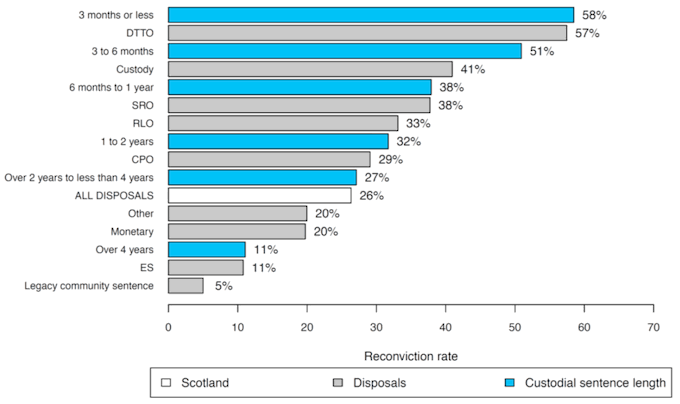
1. Chart 10 shows reconviction rates for each disposal type. The category, Custody, shows reconviction rates for all offenders discharged from a prison or young offender institutions in 2017-18. SROs and ES are presented separately from the Custody category. Custodial sentence lengths includes all custodial sentences (prison, young offender institutions, ES, and SROs).
Most custodial sentence lengths showed a decrease in reconvictions in the past year, except over six months to one year which increased (Table 10a).
Over the past year, decreases in reconviction rates for different lengths of custodial sentences ranged from 2.3 percentage points for sentences of over one year to two years, to 0.8 percentage points for three months or less. Decreases in average number of reconvictions rates ranged from 7% for three months or less, to 3% for over three months to six months. The average number of reconvictions decreased by 8% for the over four years group, but this reflects a small change in the actual value from 0.13 to 0.12.
In contrast to other sentence lengths, reconvictions increased for the over six months to one year age group in the past year. The reconviction rate increased by 2.6 percentage points from 37.9% to 40.5% and the average number of reconvictions increased slightly from 0.71 to 0.72.
The picture is somewhat complicated over the longer term for all sentence lengths (Table 10a). Over the past 21 years, reconvictions have fluctuated for most sentence lengths with no clear upwards or downwards trend. However, the reconvictions for sentences of three to six months and over four years have decreased over the past 21 years.
Table 10b shows reconviction rates and average number of reconvictions for all custodial sentences of one year or less from 1997-98 to 2017-18. These combine all the one year or less custodial sentence length reconvictions that are presented in Table 10a. This table has been included in response to user need for these figures due to high interest around the extension of the presumption against short sentences from three months or less to one year or less. Note that the extension of the presumption against short sentences came into force on 4th July 2019 and only applies to offences committed on or after this date. Therefore this bulletin does not currently contain any figures after the introduction of the extension.
1.7 Conviction history prior to index conviction
(Table 11)
Conviction history is a strong predictor for the likelihood of reconviction, as reconviction rates increase with increasing numbers of previous reconvictions. Offenders with more than 10 previous convictions have the highest reconviction rates, whereas offenders with no previous convictions in the past ten years have the lowest reconviction rates. This pattern holds true even when age, sex, or disposal (all of which have an association with the likelihood of reconviction) are taken into account (Table 11).
1.8 Two year rates
(Table 14)
Reconviction rates in Scotland were reported with a two-year follow-up period before the 2009-10 cohort bulletin. After this point, the focus has been on a follow-up period of one year rather than two years as, in general, the one-year rate tracks the two year rate, and has the benefit of being more timely.
Using the two-year follow up period there has been a decrease in the reconviction rate and in the average number of reconvictions per offender every year from 2009-10 onwards (Table 14). The reconviction rate of 37.2% in 2016-17 was very similar to the figure of 37.4% in 2015-16, and the average number of reconvictions was similar with a figure of 0.86 in 2016-17 compared to 0.87 in 2015-16. Over 10 years from 2007-08 to 2016-17, the average number of reconvictions per offender has fallen by 19% from 1.06 to 0.86, and the reconviction rate saw a 5.3 percentage point reduction from 42.5% to 37.2%.
These declining trends mirror those seen for the one-year follow up period (Table 1) but as there is a longer follow-up period, the associated values are typically greater, for instance:
- In 2016-17, the two-year reconviction rate was 10.9 percentage points higher than the one-year reconviction rate for 2017-18 (37.2% for the two year compared to 26.3% for the one year rate).
- The average reconvictions per offender are over a third of a conviction (0.40) higher for the two-year rate (0.86 reconvictions per offender on average over two years, compared to 0.46 over one year).
Contact
Email: Justice_Analysts@gov.scot
There is a problem
Thanks for your feedback